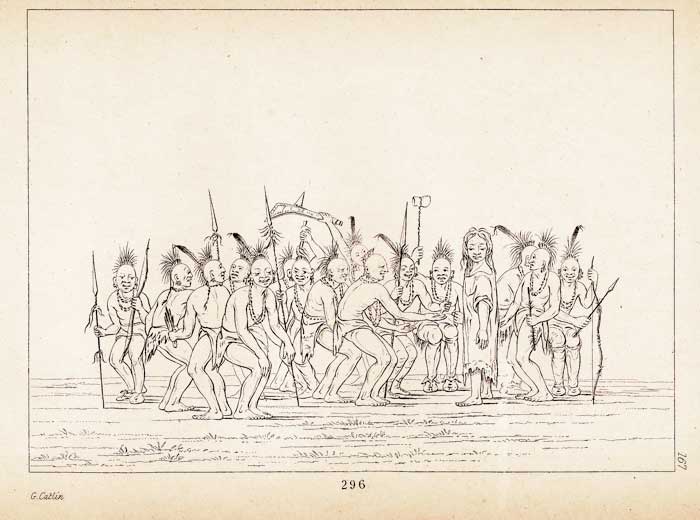Difference between revisions of "Wilson Collection: The Berdache"
(Berdache) |
(berdache) |
||
| (4 intermediate revisions by the same user not shown) | |||
| Line 1: | Line 1: | ||
| − | [[File: | + | [[File:Berdachefixed.jpg]] |
''(Print of “Dance to the Berdashe” by George Catlin from the 1903 edition | ''(Print of “Dance to the Berdashe” by George Catlin from the 1903 edition | ||
of his North American Indians…Written…1832-1839)'' | of his North American Indians…Written…1832-1839)'' | ||
| − | + | '''The Berdache''' | |
| − | ''' | + | In the 1830’s painter George Catlin depicted a dance honoring a Fox-tribe berdache, or i-coo-coo-a. He described him as “a man dressed in woman’s clothes.”<ref>Jonathan Katz, ''Gay American History: Lesbians and Gay Men in the U.S.A.'' (New York: Thomas Y. Crowell, 1976), 302.</ref> An eyewitness to a similar Fox tribal event in 1902 said dance movements included “pretended love-making” between the berdaches and the tribesmen dancing with them.<ref>Gay American Indians, ''Living the Spirit: A Gay American Indian Anthology'', ed. Will Roscoe (New York: St. Martin’s Press, 1988), 53.</ref> Apparently the dancers were the i-coo-coo-as’ sexual partners or lovers.<ref>Gay, 54.</ref><ref>Will Roscoe, ''Changing Ones: Third and Fourth Genders in Native North America'' (New York: St. Martin’s Griffin, 1998), 9.</ref> |
| + | |||
| + | In 1856, Edwin Denig, a fur trader among the Crow tribe, remarked, “Strange country this, where males assume the dress and perform the duties of females, while women turn men and mate with their own sex!”<ref>Katz, 310.</ref> | ||
| − | + | ==''References''== | |
| + | <references /> | ||
| − | |||
| − | |||
| − | + | ==''To return to "Exhibit contents" links, click:''== | |
| − | + | ==[[Rich Wilson: Aspects of Queer Existence in 19th-Century America]]== | |
| − | |||
| − | |||
| − | |||
Latest revision as of 11:18, 26 November 2012
(Print of “Dance to the Berdashe” by George Catlin from the 1903 edition of his North American Indians…Written…1832-1839)
The Berdache
In the 1830’s painter George Catlin depicted a dance honoring a Fox-tribe berdache, or i-coo-coo-a. He described him as “a man dressed in woman’s clothes.”[1] An eyewitness to a similar Fox tribal event in 1902 said dance movements included “pretended love-making” between the berdaches and the tribesmen dancing with them.[2] Apparently the dancers were the i-coo-coo-as’ sexual partners or lovers.[3][4]
In 1856, Edwin Denig, a fur trader among the Crow tribe, remarked, “Strange country this, where males assume the dress and perform the duties of females, while women turn men and mate with their own sex!”[5]
References
- ↑ Jonathan Katz, Gay American History: Lesbians and Gay Men in the U.S.A. (New York: Thomas Y. Crowell, 1976), 302.
- ↑ Gay American Indians, Living the Spirit: A Gay American Indian Anthology, ed. Will Roscoe (New York: St. Martin’s Press, 1988), 53.
- ↑ Gay, 54.
- ↑ Will Roscoe, Changing Ones: Third and Fourth Genders in Native North America (New York: St. Martin’s Griffin, 1998), 9.
- ↑ Katz, 310.
